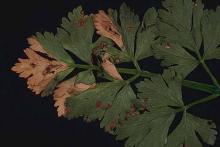Cause A bacterium, Pseudomonas syringae pv. apii, that overwinters in celery refuse and on celery seed.
Symptoms At first, a water-soaked spot appears on leaves and becomes bright yellow. The center of the spot gradually turns into a brown, necrotic spot with a yellow halo.
Cultural control
- Eliminate bacteria in seed by soaking at 118°F for 30 min.
- Obtain clean transplanting stock. Plants produced in ebb and flow greenhouses are less likely to be infected than those grown under sprinklers.
- Do not mow or handle transplants when they are wet. If feasible, plant only in dry weather.
- Avoid mechanical operations in the field that can spread the bacteria, particularly when plants are wet with dew or irrigation water.
Chemical control Spray plants to prevent spread. Sprays usually are necessary only in cool, wet weather. Sprays are effective only if applied before blight appears, to reduce bacterial populations on leaves. Later applications often are ineffective due to the bacteria's resistance.
- Copper (Group M1) formulations offer limited control.
- Badge SC at 1 to 4 pints/A on 7-day intervals. Preharvest interval is 0 days. 24-hr reentry for greenhouse use; 48-hr reentry for all other applications.
- C-O-C-S WDG at 1 to 1.9 lb/A. 48-hr reentry.
- Cueva at 0.5 to 2 gal/100 gal water on 7- to 10-day intervals. May be applied on the day of harvest. 4-hr reentry. O
- Kocide 2000 at 1.5 lb/A or Kocide 3000 at 0.75 to 1.5 lb/A on 7-day intervals. 48-hr reentry. O
- Nu-Cop DF WP at 2 lb/A on 7-day intervals. 48-hr reentry. O
- Previsto at 1 to 2 quarts/A on 7-day intervals. 48-hr reentry. O
Reference Little, E.L., Koike, S.T., and Gilbertson, R.L. 1992. Association of Pseudomonas syringae pv. apii with celery seed. Phytopathology 82:1072.

